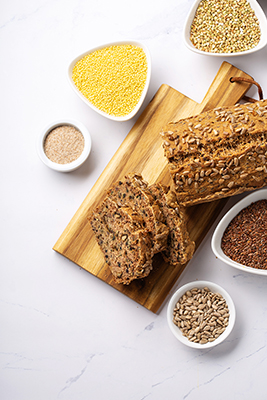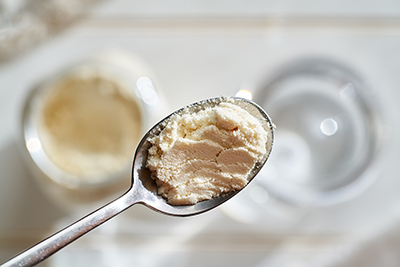Fibre Factor: Are You Getting Enough?
Most of us have heard that we need to get more fibre, but how many understand what it really is, how it works in our body, and why it’s so important to our health? And above all, are you certain you’re getting enough?
What Is Fibre?
Dietary fibre is a type of carbohydrate consisting of remnants of edible plant cells, polysaccharides, lignin, and associated substances, that are not digested by the body, particularly in the small intestines of humans. Fibre passes through the intestinal tract relatively intact, compared to other types of carbohydrates, which are broken down into more digestible sugar molecules.
Fibre, also known as “bulk” and “roughage,” can be grouped into two categories: insoluble fibres and soluble fibres. Insoluble fibres include cellulose, lignin, and many hemicelluloses. Soluble fibres include pectin, gums, and some hemicelluloses.[1], [2], [3]
Insoluble v. Soluble Fibres?
Determining which dietary fibre source is soluble versus insoluble can be confusing, because most sources have overlaps in composition. Although it is generally recommended to consume fibre altogether, a fibre source’s solubility in water matters. Evidence shows one type to be better suited for certain physiological functions and health conditions than the other. Insoluble fibre has the capacity to hold water—this makes stools bulkier and softer, allowing them to pass through the intestinal tract easier. Consuming insoluble fibre may help manage constipation and abdominal straining, and potentially prevent the development of diverticular disease, hemorrhoids, and varicose veins. Soluble fibre, on the other hand, mixes well with water to form a gel, which delays gastric emptying and plays a role in satiety and decreasing overeating. Both insoluble and soluble fibre have been shown to delay glucose absorption from the small intestine, making them suitable for managing diabetes.[4], [5], [6]
Canadians Aren’t Getting Enough Fibre!
A study assessed the results of a 2015 Canadian Community Health Survey, conducted to estimate of the usual intake of nutrients and monitor the diet quality of different populations. Results were derived from the participants’ reported daily diets: Their usual intakes of macronutrients (including fibre) and micronutrients (i.e., vitamins and minerals) were compared to the recommended acceptable intakes. It was deemed that a significant number of Canadian adults may not be meeting recommendations for several essential nutrients, which may be contributing to nutrient inadequacies. Less than 25% of adults (aged 19 years and above) had intakes above the adequate intake for fibre. Across different age-sex groups, adults consumed an average of around 17 grams of fibre per day.[7], [8]
 Where Can We Get Our Fibre?
Where Can We Get Our Fibre?
To maintain good health, children and adults need to consume at least 25 to 35 grams of fibre per day. In general, whole grains, whole fruits and vegetables, legumes, nuts, and seeds are naturally abundant in fibre. More specifically, foods with soluble fibre include oats, chia seeds, nuts, beans, lentils, apples, and blueberries. Foods with insoluble fibre include whole-wheat products (especially wheat bran), quinoa, brown rice, legumes, leafy green vegetables such as kale, almonds, walnuts, seeds, and fruits with edible layers like pears and apples.[9], [10], [11], [12] But busy schedules, limited food options, personal preferences, and aging can make it difficult to get enough fibre from our diets. Supplementation can help bridge the gap by providing convenient and efficient ways to increase fibre intake.
Why We Need to Consume Adequate Fibre
A balanced daily diet offers a positive impact on overall health. Interestingly, it seems fibre intake has a bigger role in health than just keeping you full and regulating your bowel movements. A higher intake of dietary fibre is associated with fewer metabolic diseases such as obesity, diabetes, and cardiovascular disease. Dietary fibre can significantly alter the environment within the intestines, particularly affecting the microbiome and influencing the intestinal barrier as well as the immune and hormone responses within the digestive tract. Consequently, these changes on the gut, associated with dietary fibre intake, alter the physiology and biochemistry of other major organs that are involved in nutrient absorption and detoxification (i.e., liver and kidney function).[13], [14], [15], [16]
What Happens When You Don’t Get Enough Fibre?
Accurately surveying fibre intake can be challenging, and even more so assessing fibre intake and disease progression, especially on a broader scale. In smaller-scale and more specific studies that look at fibre and people with chronic diseases, it is postulated that low intake of dietary fibre is a risk factor for both local and systemic chronic inflammation. Chronic inflammation is important to address because it sets the stage for many chronic diseases such as cardiovascular disease, diabetes, cancer, neurological issues, fertility issues, and more.[17], [18], [19], [20]
 Bulk up for the Better!
Bulk up for the Better!
The data on adequate fibre intake and its many health benefits continue to impress health-care practitioners. The challenge is almost always how to incorporate more fibre specific to your unique needs. It is very important not to hyperfocus on consuming a particular fibre for its specific health benefits. Instead, try to consume a wide variety of dietary fibre sources, and supplement as needed, to reach the daily recommendations (25–35 grams). Consulting with a qualified health-care practitioner can help to effectively manage your obstacles and optimize your health.
 Dr. Kim Abog, ND
Dr. Kim Abog, ND
Dr. Kim Abog is a registered naturopathic doctor and doula based in Toronto, Ontario. She has a special interest in fertility and reproductive health. She helps people by facilitating health-management plans with them, connecting them to evidence-informed integrative health solutions, and helping them thrive.
kimabog.com
References
[1] Barber, T.M., S. Kabisch, A.F.H. Pfeiffer, and M.O. Weickert. “The health benefits of dietary fibre.” Nutrients, Vol. 12, No. 10 (2020): 3209.
[2] Gaby, A.R. Nutritional Medicine, Second Edition, Fritz Perlberg Publishing, 2017, 1456 p., ISBN 978-09828-85000-0.
[3] Ioniță-Mîndrican, C.-B., K. Ziani, M. Mititelu, E. Oprea, S.M. Neacșu, E. Moroșan, D.-E. Dumitrescu, A.C. Roșca, D. Drăgănescu, and C. Negrei. “Therapeutic benefits and dietary restrictions of fibre intake: A state of the art review.” Nutrients, Vol. 14, No. 13 (2022): 2641.
[4] Barber et al. op. cit.
[5] Gaby. op. cit.
[6] Ioniță-Mîndrican et al. op. cit.
[7] Ahmed, M., A. Praneet Ng, and M.R. L’Abbe. “Nutrient intakes of Canadian adults: Results from the Canadian Community Health Survey (CCHS)-2015 Public Use Microdata File.” The American Journal of Clinical Nutrition, Vol. 114, No. 3 (2021): 1131–1140.
[8] Seljak, B.K., E. Valenčič, H. Hristov, M. Hribar, Ž. Lavriša, A. Kušar, K. Žmitek, et al. “Inadequate intake of dietary fibre in adolescents, adults, and elderlies: Results of Slovenian Representative SI. Menu Study.” Nutrients, Vol. 13, No. 11 (2021): 3826.
[9] Barber et al. op. cit.
[10] Gaby. op. cit.
[11] Ioniță-Mîndrican et al. op. cit.
[12] Veronese, N., M. Solmi, M.G. Caruso, G. Giannelli, A.R. Osella, E. Evangelou, S. Maggi, L. Fontana, B. Stubbs, and I. Tzoulaki. “Dietary fibre and health outcomes: an umbrella review of systematic reviews and meta-analyses.” The American Journal of Clinical Nutrition, Vol. 107, No. 3 (2018): 436–444.
[13] Barber et al. op. cit.
[14] Ioniță-Mîndrican et al. op. cit.
[15] Veronese et al. op. cit.
[16] McKeown, N.M., G.C. Fahey Jr, J. Slavin, and J.W. van der Kamp. “Fibre intake for optimal health: How can healthcare professionals support people to reach dietary recommendations?” BMJ, Vol. 378 (2022): e054370.
[17] Bach Knudsen, K.E., H.N. Lærke, M.S. Hedemann, T.S. Nielsen, A.K. Ingerslev, D.S. Gundelund Nielsen, P. Kappel Theil, et al. “Impact of diet-modulated butyrate production on intestinal barrier function and inflammation.” Nutrients, Vol. 10, No. 10 (2018): 1499.
[18] Chen, M.-S., D.-Y. Wang, H.-Y. Gong, H.-M. Zhang, J. Gao, and S.-P. Luo. “The association between dietary fibre and infertility among US Women: The National Health and Nutrition Examination Survey, 2013-2018.” Nutricion Hospitalaria, Vol. 39, No. 6 (2022): 1333–1340.
[19] Gogebakan O., A. Kohl, M.A. Osterhoff, M.A. van Baak, S.A. Jebb, A. Papadaki, J. Alfredo Martinez, et al. “Effects of weight loss and long-term weight maintenance with diets varying in protein and glycemic index on cardiovascular risk factors: The diet, obesity, and genes (DiOGenes) study: A randomized, controlled trial.” Circulation, Vol. 124, No. 25 (2011): 2829–2838.
[20] Silva, G.M.D., É.B. Durante, D. Assumpção, M.B. de A. Barros, and L.P. Corona. “High prevalence of inadequate dietary fibre consumption and associated factors in older adults: A population-based study.” Revista Brasileira de Epidemiologia, Vol. 22 (2019): e190044.

 Stores
Stores